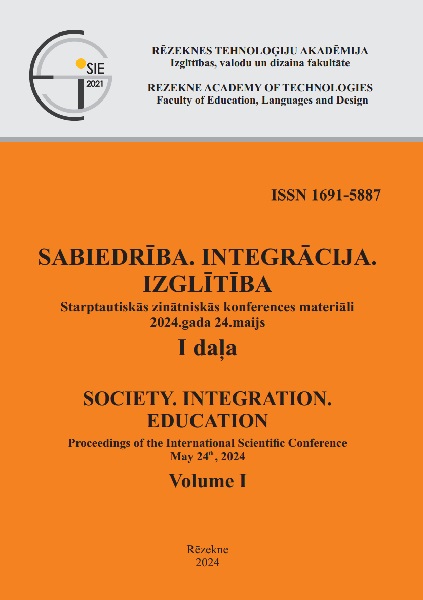PREREQUISITES FOR THE APPLICATION OF INNOVATIVE METHODS IN SOCIAL SERVICE ORGANIZATIONS
DOI:
https://doi.org/10.17770/sie2024vol1.7923Keywords:
innovations, organizations providing social services, social servicesAbstract
This article analyzes that when solving social problems, most welfare states choose a social security system model in which social service organizations provide professional services and help ensure the well-being of residents in the community. Social challenges require changes and new solutions in the activities of organizations providing social services, which can help solve emerging social problems by offering service recipients new forms of social services. The purpose of the article is to reveal the prerequisites for the application of innovative methods for the solution of social problems and the implementation of the application of new managerial practices in organizations providing social services. Applied research methods - analysis of scientific literature, interviews of social workers, analysis and interpretation of research results. The article provides a review of the scientific literature and research data that reveal the desire of social workers to apply modern technologies in social work, which help to discover new work methods and managerial practices in the social services sector. The pursuit of innovation in organizations providing social services ensures a favorable atmosphere for the creativity of employees and service recipients and provides an opportunity for the continuous improvement of employees in the organization.
References
Amabile, T. M. (1988). A model of creativity and innovation in organizations. Research in organizational behavior, 10(1), 123-167. Retrieved from: https://web.mit.edu/curhan/www/docs/Articles/15341_Readings/Group_Performance/Amabile_A_Model_of_CreativityOrg.Beh_v10_pp123-167.pdf
Amabile, T. (2011). Componential theory of creativity. (pp. 538-559). Boston, MA: Harvard Business School. Retrieved from: https://edisciplinas.usp.br/pluginfile.php/4927777/mod_resource/content/0/TeresaAMabile.pdf
Agbor, E. (2008). Creativity and innovation: The leadership dynamics. Journal of strategic leadership, 1(1), 39-45.
Bartlett, C.A., Ghoshal, S. (1995). Changing the role of top management: beyond systems to people. Harvard business review, 73(3), 132-142.
Birdi, K., Leach, D., Magadley, W. (2016). The relationship of individual capabilities and environmental support with different facets of designers' innovative behavior. Journal of Product Innovation Management, 33(1), 19-35.
Bridgeforth, B.W. (2005). Advancing the practice of leadership: A curriculum. Journal of leadership education, 4(1), 4-30.
Croitoru, A. (2012). Schumpeter, JA, 1934 (2008), The theory of economic development: An inquiry into profits, capital, credit, interest and the business cycle. Journal of comparative research in anthropology and sociology, 3(02), 137-148.
Čižikienė, J. (2020). Vadovų lyderystė pasirenkant diegti Europos socialinių paslaugų kokybės užtikrinimo sistemą (Doctoral dissertation, Vilnius: MRU). Retrieved from https://cris.mruni.eu/server/api/core/bitstreams/7f3b96fb-6562-4230-b2aa-bd8c1b385088/content
Davila, T., Epstein, M., Shelton, R. (2012). Making innovation work: How to manage it, measure it, and profit from it. FT press.
Demircioglu, M.A. (2016). Organizational innovation. Global encyclopedia of public administration, public policy, and governance, 1-5. DOI:10.1007/978-3-319-31816-5_3017-1
Dinh, J.E., Lord, R.G., Gardner, W.L., Meuser, J.D., Liden, R.C., Hu, J. (2014). Leadership theory and research in the new millennium: Current theoretical trends and changing perspectives. The leadership quarterly, 25(1), 36-62. DOI: https://doi.org/10.1016/j.leaqua.2013.11.005
Gudžinskienė, V., Gečienė, J. (2018). Quality assessment of the services provided by the elderly people social care institutions. Social Inquiry into Well-Being, 16(2), 165-189. Retrieved from: https://ojs.mruni.eu/ojs/social-inquiry-into-well-being/article/view/4906
Henry, J.S. (2012). The price of offshore revisited. Tax Justice Network, 22, 57-168. Retrieved from: http://taxjustice.nonprofitsoapbox.com/storage/documents/The_Price_of_Offshore_Revisited_-_22-07-2012.pdf
Labanauskas, L. (2017). Socialinės inovacijos ir kūrybiškumas švietimo ir inovacijų politikos kontekste. Social Education/Socialinis Ugdymas, 47(3). DOI: https://doi.org/10.15823/su.2017.20
Little, L.M., Gooty, J., Williams, M. (2016). The role of leader emotion management in leader–member exchange and follower outcomes. The Leadership Quarterly, 27(1), 85-97. DOI: https://doi.org/10.1016/j.leaqua.2015.08.007
Lepik, K.L., Urmanavičienė, A. (2022). The role of higher education institutions in development of social entrepreneurship: The case of Tallinn University social entrepreneurship study program, Estonia. Social innovation in higher education, 129. DOI: https://doi.org/10.1007/978-3-030-84044-0
Kautz, K., & Larsen, E. Å. (2000). Diffusion theory and practice: Disseminating quality management and software process improvement innovations. Information Technology & People, 13(1), 11-26.DOI: https://doi.org/10.1108/09593840010312726
Kang, J.H., Solomon, G.T., Choi, D.Y. (2015). CEOs' leadership styles and managers' innovative behaviour: Investigation of intervening effects in an entrepreneurial context. Journal of Management studies, 52(4), 531-554.
Kiel, G.C., Hendry, K., Nicholson, G.J. (2006). Corporate governance options for the local subsidiaries of multinational enterprises. Corporate Governance: An International Review, 14(6), 568-576.
Kotler, P. (2011). Reinventing marketing to manage the environmental imperative. Journal of marketing, 75(4), 132-135.
Kubiliūtė, G., Neverauskienė, L. O. (2023). Socialinių inovacijų plėtros kliūčių analizė Lietuvoje. Retrieved from: https://vilniustech.lt/files/5169/258/12/3_0/vvf_2023%20-%20035.pdf
Matthews, C.H., Brueggemann, R. (2015). Innovation and entrepreneurship: A competency framework. Rousstledge.
Mumford, M.D., Gustafson, S.B. (1988). Creativity syndrome: Integration, application, and innovation. Psychological bulletin, 103(1), 27. DOI: https://doi.org/10.1037/0033-2909.103.1.27
Mueller, S.D. (2020) High-stakes ethnic politics. In N Cheeseman, K Kanyinga and G Lynch(eds) The Oxford Handbook of Kenyan Politics. Oxford: Oxford University.
Nguyen, T.T., Mia, L., Winata, L., Chong, V.K. (2017). Effect of transformational leadership style and management control system on managerial performance. Journal of Business Research, 70, 202–213. DOI: https://doi.org/10.1016/j.jbusres.2016.08.018
Rogers, J.C. (1983). Eleanor Clarke Slagle Lectureship—1983; clinical reasoning: the ethics, science, and art. The American Journal of Occupational Therapy, 37(9), 601-616. DOI: https://doi.org/10.5014/ajot.37.9.601
Oke, A., Munshi, N., Walumbwa, F. O. (2009). The influence of leadership on innovation processes and activities. Organizational Dynamics, 38(1), 64-72.
Salter, A., Alexy, O. (2014). The nature of innovation. The Oxford handbook of innovation management, 26-49.
Satalkina, L., Steiner, G. (2022). Social innovation: a retrospective perspective. Minerva, 60(4), 567-591. DOI: https://doi.org/10.1007/s11024-022-09471-y
Shalley, C.E., Zhou, J. (2008). Organizational creativity research: A historical overview. Handbook of organizational creativity, 331, 3-31.
Souba, W.W. (2014). The phenomenology of leadership. Open Journal of Leadership, 3(04), 77.
Spencer, J. (2003). Learning and teaching in the clinical environment. BmJ, 326(7389), 591-594. doi: https://doi.org/10.1136/bmj.326.7389.591
West, M.A., Richter, A.W. (2008). Climates and cultures for innovation and creativity at work. Handbook of organizational creativity, 211-236.
Zhou, J. (2003), When the presence of creative coworkers is related to creativity: role of supervisor close monitoring, developmental feedback, and creative personality, Journal of Applied Psychology, 88, 413-422. https://doi.org/10.1037/0021-9010.88.3.413
Židžiūnaitė, V., Sabaliauskas. (2017). Kokybiniai tyrimai: principai ir metodai. Vilnius: Vaga.






